The Breakdown
Pros
Cons
An Intercom-Ready Super Value
The sub-$250 helmets made by Bell are probably the best-kept secrets in motorcycling. HJC overshadows everyone else when it comes to value-priced helmets and there’s nothing wrong with that. But there’s something extra special about the $100 to $250 helmets in the Bell lineup and we have reviewed nearly all of them at one time or another. That includes helmets like the Bell Vortex (review), the Bell Sprint (review) and the Bell Arrow (review).
They’re all are (or were) amazing values with excellent quality, lots of features borrowed from theBell Star (review) and sharp styling. Bell calls this “bang for the buck” and we definitely agree. But somehow, we missed reviewing the Bell Qualifier and its rich cousin introduced in 2014, the Bell Qualifier DLX.
A series of events, starting with a visit to the Cardo Systems booth at the 2015 AIMExpo (report)changed all that and we’ve been wearing a DLX for the last few weeks…that is, until the massive snowstorm hit the U.S. east coast recently.
I can say this with certainty: the Qualifier DLX once more proves that Bell makes better “value priced” helmets than anyone else. For example, the DLX includes the Transitions photochromic (darkens in the presence of UV light) face shield, treated with Bell’s “NutraFog II” anti-fog coating. It also has the fantastic Bell “ClickRelease” face shield release with its micro-click raising and lowering system — it’s one of the best in the business.
Excellent all-around ventilation includes a chin vent with not one but two vent ports that flow air through the chin bar. And how about a brow vent? It’s rarely found on a helmet in this price range and it’s just like the one on an Arai costing 3x more.
Factor in the Bell Helmets five-year warranty and you’d have a winner.
But how about the best bonus feature of all: the Qualifier DLX has a built-in port that accepts either the Cardo Q1 or Q3 intercom (review), the basic Cardo Qz (review) or the Sena SMH10 (review) and the new Sena 10S (review).
The SMH10 is a bit long in the tooth and about to be replaced by the 10S and the Cardo Q1/Q3 pair are relatively new and a perfect match for the Qualifier DLX. An optional adapter is necessary, however, to install either intercom. We’ve been using the slightly higher-spec Q3 along with the optional 40 mm Cardo speaker set. The upgraded speakers are a noticeable improvement over the stock speakers that come with the Q1/Q3 (which are actually pretty good also). And if you want even more volume, hook up a new Iasus EAR3 amplifier (review) for music as loud as you can handle.
We feel that all of this potential makes the Bell Qualifier DLX the best sub-$250 helmet you can buy today. Let’s take a look.
See Also: Helmet Buyers Guide, Helmet Review Home and all Bell Helmet Reviews.
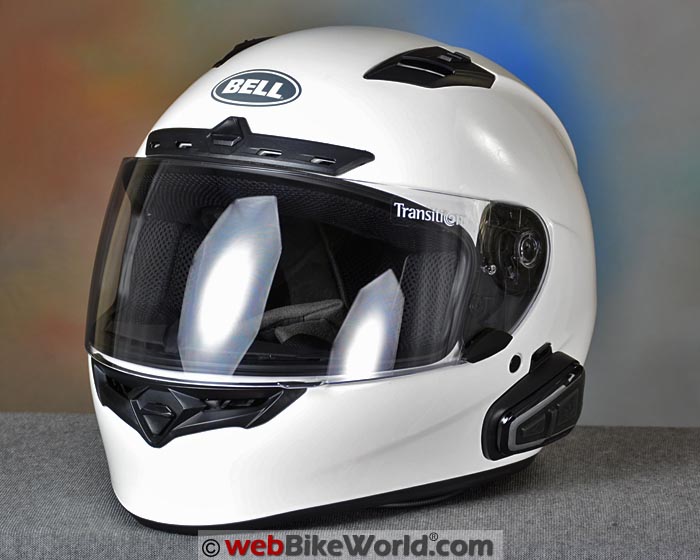
The Qualifier DLX Equation
Ask most motorcyclists about inexpensive quality helmets and they’ll probably say “HJC”. The Korean company’s bread-and-butter line of helmets may not have leading-edge features or the most stylish designs, but you usually get a lot of helmet for your money.
However, when it comes to “bang for the buck”, Bell has it covered. Examples? How about the Bell Vortex we reviewed back in 2010 that’s still in the lineup. It was a lot of helmet back then for the $179.99 list price and guess what? The price hasn’t changed.
Well, actually, it lists for $0.05 less than it did 6 years ago.
I’m not exactly sure how the Bell lineage progressed after the Vortex, but the Qualifier DLX surely is in the same family tree.
As its name suggests, the DLX is a deluxe version of the Bell Qualifier, which is a $109.95 (list) helmet that includes the excellent Bell “ClickRelease” face shield system, a removable liner, speaker pockets and it even has a 5-year warranty.
The Qualifier DLX costs another $140.00 over the basic Qualifier; not insignificant if you’re on a budget.
But for the extra dosh, you get the Transitions photochromic face shield, which is actually a $119.95 option for the Qualifier or a $139.95 option for the Bell Vortex.
Also included on the Qualifier DLX is a brow vent, rare at this price range. Throw in the 5-year warranty, an included chin curtain, a removable liner and excellent ventilation, and you have something of a bargain.
“But wait”, as they say, “there’s more!”
Shopping Now? We Recommend
webBikeWorld has worked closely with RevZilla over the years to provide our testers with products to review. In addition to being a great site to shop from, they’re also a great partner. Both Amazon and Revzilla have a big selection of helmets from the great helmet manufacturers.
RevZilla
Free shipping on orders over $40
30-day no-nonsense return policy
Excellent selection of all major brands
Awesome pricing
Intercom Adapter Kit
Possibly the best feature of the DLX is underneath that removable cover on the left-hand side. Pop it off, install the optional adapter and you can plug in a Cardo Q1/Q3 intercom (review) or the basic Cardo Qz (review) or even the original Sena SMH10 (review).
To fit the Cardo Qz, Q1 or Q3 ($139.95, $159.95 or $219.95) or the Sena SMH10 or Sena 10S (review) to the DLX, you’ll need the Bell Cardo scala rider adapter kit ($59.95).
And by the way, the adapter also works with the Bell MAG-9 helmet that is currently in the webBikeWorld review queue.
It includes a simple plastic surround that fits the Cardo intercom module and then snaps into the recess in the helmet. The kit also includes a special boom mic mount that slips inside the helmet and adapts to the inserted Qz, Q1 or Q3 intercom module.
Add the optional Cardo 40 mm speakers ($32.95) we covered in the Iasus EAR3 amplifier reviewand you’ll have yourself an exceptional helmet with the equivalent of a factory-installed intercom system and a rockin’ pair of speakers.
Even better, you still have the helmet mounts that came with the Q-series intercom, which you can then add to another helmet. Pull the intercom module out of the DLX and pop it on your other helmet and you’re ready to go.
And finally, the dual intake vents in the chin bar are placed on either side of center, at the outer edges of the ABS in back of the chin bar.
This gives a good spot to place the wired microphone directly in the center of the chin bar, without the interference you might get from a single vent port.
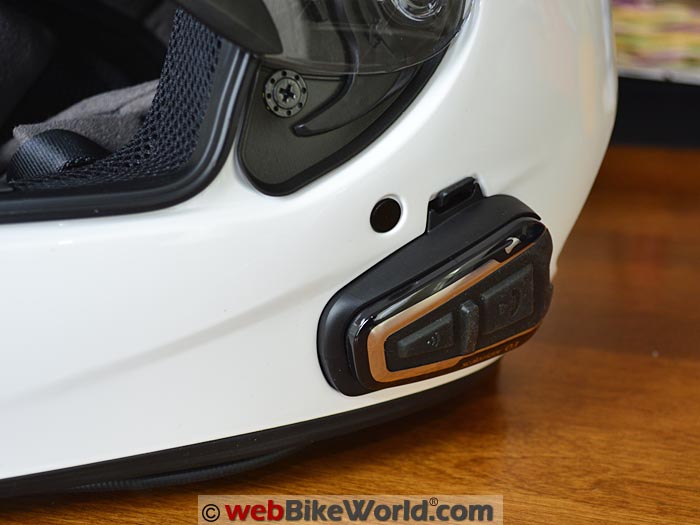
Paint, Graphics and Overall Quality
Our Qualifier DLX is in the basic gloss white and we’ve seen and handled all of the 13 available Qualifier DLX colors and they’re all very nicely made and exhibit high quality.
The paint on this white example is perfectly applied, with a smooth and even finish. There are absolutely zero flaws, runs, orange peel, dust or anything else, and that’s not always the case at this price.
The chin vent, brow vent and top vent sliders have a solid feel, clicking open and closed. And the vent designs also allow air to pass directly through, again unlike many other helmets in this price range that have flimsy vent covers that don’t open far enough to function.
The removable liner is nicely padded with a comfortable fabric and there’s that “ClickRelease” face shield that works like a charm.
Score: Overall, I’ll rate the Qualifier DLX as “Outstanding” for paint and quality. See the Summary Table at the end of this page for a description of our rating system.
Qualifier DLX Fit, Internal Shape and Liner
First, let’s talk about sizing. The Bell size chart lists the Qualifier DLX in size large (the helmet shown here) as fitting a 59-60 cm head. We think this helmet runs one size small and the size large fits a 58-59 instead.
Checking some of the owner comments, quite a few owners agree with the conclusion that the DLX in size large fits one size small.
Bell uses three shell sizes for the Qualifier DLX — another very unusual approach for a helmet in this price range (for example, SCHUBERTH has only 2 shell sizes for the C3 series, despite it’s $800 price tag).
The shell size/head size breakdown is the small shell for size XS, S and M; the medium shell for M and L and the large shell size for XL and 2XL. If we knew then what we know now, we’d have ordered an XL.
The very tight fit for a 60 cm head makes it more difficult to accurately assess the internal shape, but like most other helmets made today, it feels like a “Neutral” but tends towards “Slight Round” in the webBikeWorld helmet shape terminology.
The padding feels thick enough and the fabric liner is comfortable, but the padding is slightly “flabby”, not firm.
The DLX shell shape also has some taper towards the bottom, all of which means that shoving that 60 cm head inside isn’t easy and the liner padding compresses to the max.
Bottom line here is that it’s probably best to figure that you’ll have to order one size up. In this case, it’s very important to try before you buy.

More information on helmet fit can be found in the webBikeWorld Motorcycle Helmet FAQ page.
Also, see the chart that lists the helmet weights of webBikeWorld reviewed helmets and also by shape on the webBikeWorld Motorcycle Helmet Shapes page.
Score: I’ll give the Qualifier DLX a “Very Good” rating for internal shape but be sure to check that the size will fit before you buy.
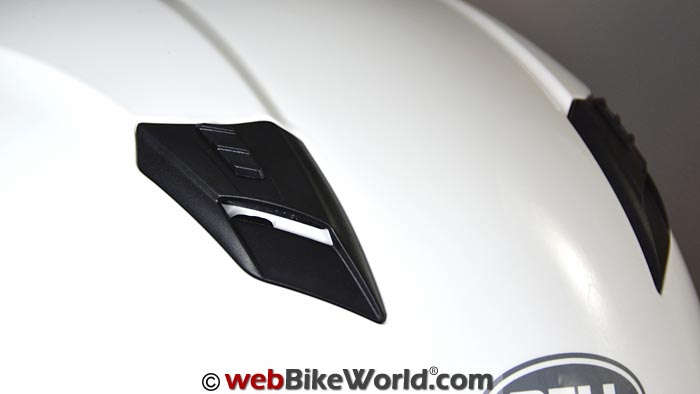
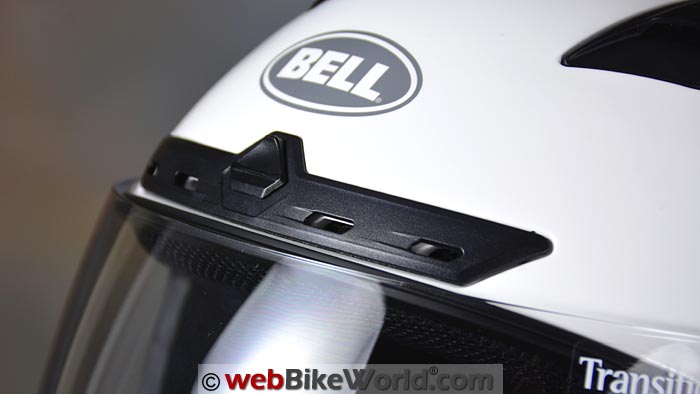
Transitions Photochromic Face Shield
The Qualifier DLX comes with the Transitions photochromic face shield as standard equipment in the U.S. and UK.
We were the first to report on a photochromic visor for motorcycle use in 2007 with the Sunshift photochromic visor review. That was followed up with the Akuma Gemini Tint-on-Demand visor review in 2008 and the Transitions SolFX photochromic visor review in 2009.
All three of those products were developed by the now-defunct Akuma Helmets.
The photochromic system has its pros and cons; many owners really like the face shield, which darkens in the presence of UV light.
Note that the face shield will darken during just about all daylight conditions including overcast, so you end up with what is effectively a dark tinted face shield. It will not instantly change from light to dark and back again as you ride in and out of the sun and shadows.
The Transitions visor does darken very quickly but it takes quite a while longer to revert back to clear and this will vary, depending on the ambient temperature.
That’s the realm of the electrochromic face shield, which has a powered on/off switch for instant clearing or tint, but that technology has yet to be perfected. (See our e-Tint LCD visor review for an example of electrochromic technology.)
Nevertheless, many motorcycle owners simply love their Transitions photochromic visor.
Face Shield, Eye Port and Visibility
The Bell “ClickRelease” face shield system is still one of the best there is for ease of use. It has a very fine set of clicking detents as the face shield is moved up or down and a first opening for defogging.
That first opening could be a little smaller however, because it leaves about a 15 mm opening, too much really for simple defogging or a slight amount of fresh air.
Also, the 2.28 mm thick face shield on our example feels just a touch flimsy. It bends slightly as it’s lifted with the tab on the left. If the tab were molded at the lower center part of the face shield, this problem would be eliminated while making it easier to lift with either hand.
Despite the black plastic oval shaped piece at the lower left, the face shield on the DLX does not lock. It would have been nice if Bell had added the detent on the eye port to allow the shield to friction lock in place when closed.
Probably the best part of the ClickRelease face shield is how easy it is to remove and replace. You can see this in the video below, but the system couldn’t be easier or more simple.
We’ve said this many times for many years, but other helmet manufacturers need to stop trying to reinvent the wheel and license Bell’s system.
The face shield is labeled as meeting VESC-8 standards and it has excellent optical properties. The eye port provides slightly better than average outward visibility and the simple but full-surround eye port gasket does a good job at blocking any moisture from entering.

Score: I’ll give the DLX an “Excellent” for above average outward visibility and the sealing performance of the face shield.
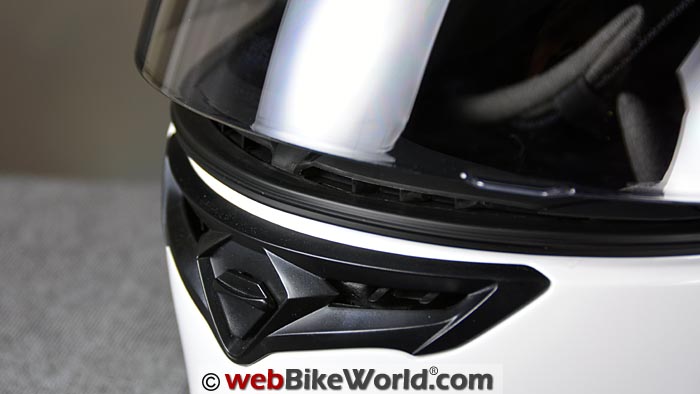
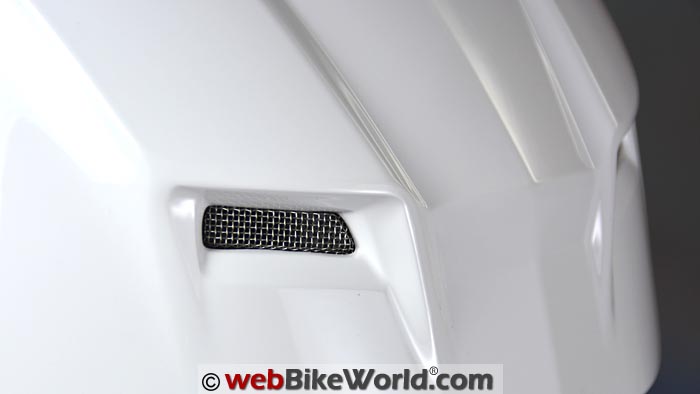
DLX Ventilation
Lower-end helmets usually have pretty poor ventilation, but the Qualifier DLX is definitely an exception to that rule.
The chin vent opens a wide horizontal bar, shaped like a wing, that directly flows air through two vertical ports in the chin bar, one on each side of center.
This brings a lot of air into the helmet with a portion of the air flow split to enter the top of the breath guard through the center, just above the tab that opens and closes the chin vent.
The Qualifier DLX also has a brow vent that opens via a central tab, which opens four small vents. The air passes behind the brow band of the liner and up into the top of the helmet.
The two top vents open and close independently and flow air directly through holes in the EPS and down on to the rider’s head. The direct air passage can be seen right into the helmet. There are also two mesh-covered exhaust ports in the rear with two smaller ports at the lower rear.
All of this gives the Qualifier DLX excellent ventilation, albeit with some noise, especially around the top vents. But overall, the Qualifier DLX has among the best ventilation and air flow you’ll find at any price.

Score: I’ll give the Qualifier DLX ventilation system and operation of the parts a score of “Outstanding”.
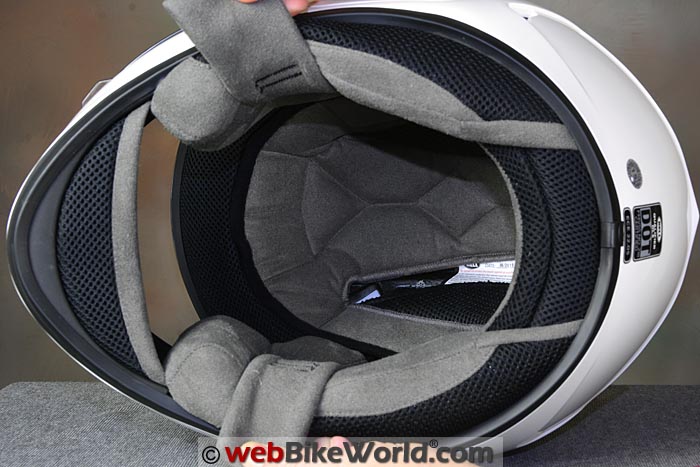
Sound Levels
The Qualifier DLX is slightly louder than average, a trade-off probably for the large amounts of air that can enter through the vents. When the vents are closed, the noise decreases and this is especially noticed around the top vents.
The noise around the bottom of the helmet is well controlled, mostly due to the taper along the bottom of the shell, which helps keep wind and noise from entering from underneath the helmet.
Overall, I’d rate the Qualifier DLX as slightly louder than average at the top when the vents are open.

Score: I’ll give the Qualifier DLX a “Very Good” for slightly worse than average noise levels.
wBW Video: Bell Qualifier DLX Helmet
Where to find the Bell Qualifier DLX
webBikeWorld has worked closely with RevZilla over the years to provide our testers with products to review. In addition to being a great site to shop from, they’re also a great partner. Both Amazon and Revzilla have a big selection of helmets from the great helmet manufacturers.
RevZilla
Free shipping on orders over $40
30-day no-nonsense return policy
Excellent selection of all major brands
Awesome pricing
Helmet Weight
This Qualifier DLX in size large weighs 1567 grams (3 lbs., 7-1/4 oz.) without the intercom. The Cardo Q3 with the Qualifier DLX adapter weighs 52 grams (1-7/8 oz.)
That’s about the same as the old Bell Arrow (review) and 1567 grams is relatively light, so the Qualifier DLX is in the bottom 30% of helmet weights of the 253 full-face helmets we’ve reviewed to date.
All of these weights are available on the wBW Motorcycle Helmet Weights page, along with a chart that lists the helmets by weight and shape on the wBW Motorcycle Helmet Shapes page.
Score: I’ll give the Qualifier DLX an “Excellent” for relatively low weight and excellent balance.
Miscellaneous
The Qualifier DLX has a five-year warranty, unusual in this price range. The chin strap uses double D-rings. Different sized cheek pads are available for a custom fit.
The Qualifier DLX meets the DOT standard in the U.S. and the Qualifier DLX helmet is sold in Europe also, where it meets the CE standards. It lists for £179.99 in the UK.
| webBikeWorld Overall Opinionator: Bell Qualifier DLX | |
|---|---|
| Picks… | …and Pans |
|
|
Conclusion
The Bell Qualifier DLX has just about everything you’d find in a much more expensive helmet. So the question is, why pay more? You can spend a lot more if you wish but you still wouldn’t have a Transitions face shield and the plug-and-play intercom connectivity. Also, the ventilation system is about the best you’ll find in a full-face helmet and the five-year warranty is icing on the cake.
| wBW Product Review: Bell Qualifier DLX Helmet | |
|---|---|
| Manufacturer: Bell Helmets | List Price: $249.95 |
| Colors: Solids and graphics | Made In: China |
| Sizes: XS-2XL | Review Date: January 2016 |
| Shell Sizes: 3 | |
|
Rating Scale is subjective: Unacceptable, Poor, Neutral, Very Good, Excellent, Outstanding.
|
|
webBikeWorld has worked closely with RevZilla over the years to provide our testers with products to review. In addition to being a great site to shop from, they’re also a great partner. Both Amazon and Revzilla have a big selection of helmets from the great helmet manufacturers. Free shipping on orders over $40 Free shipping (with Amazon Prime)Buying the Bell Qualifier DLX
RevZilla
![]()
30-day no-nonsense return policy
Excellent selection of all major brands
Awesome pricingAmazon
![]()
30-day return policy
Excellent selection
Competitive pricing
Owner Comments and Feedback
See details on submitting comments.
From “R.M.” (February 2017): “First off, great review — as are all your articles! I’ve purchased the Qualifier DLX and I’m interested in adding the Sena.
I’ve found conflicting opinions about the fitment of the 10S, versus the SMH-10. Your picture is very convincing evidence that it will work 🙂
[Editor’s Note: See “M.M” comments below for photo.]
My question concerns the boom mic that is standard with the Bell Sena clamp. Is it true that it cannot be swapped for a wired mic?
If not, how does the boom mic fit in the Qualifier DLX? I would think it would be a little cramped.”
Editor’s Reply: I’d say get the 10S, the SMH10 is a very old design now, the 10S is a few generations newer and as you can see in the photo (M.M. comments below), it fits the adapter.
I just looked at my adapter, I see no way of using a wired mic, it looks like the boom mic is hard-wired and there is no auxiliary input that I can see, but I’ll check with Cardo.
But the boom mic fits fine, at least in my helmet, I almost always use a boom mic anyway.
I don’t like to wire in a mic and have to fuss with the chin vent intake, which can cause a lot of background noise when a wired mic is stuck on the back of the chin bar.
Also, I find the wired mic on the back of the chin bar to be too far away from my mouth anyway.
A wired mic can’t be adjusted inward, sometimes you need the mic right next to your lips for anyone to hear you talk and to get the least amount of outside noise interference.
But, it also depends on how the helmet fits your head shape, some helmets have a tight chin bar but I have never found a helmet that’s so tight that a boom mic won’t fit.
From “D.J.” (December 2016): “A couple of comments on your review. First, my experience confirms what you say about the sizing issue.
I bought the Qualifier DLX at a discount as part of a deal when I bought a new motorcycle.
I’m used to wearing HJC helmets in size large (CL-17, IS Max BT, more recently IS-17), and have found the Bell Qualifier in size large to be somewhat smallish.
My head circumference is a spot on 58.5 cm, which puts me squarely in Bell’s Large size category of 59-60 cm.
However, as much as I love the Qualifier low profile (especially compared to the HJCs’ somewhat bulky feel), light weight, and that wonderful transitions shield, I have not used it that much because it leaves indentations in the sides of my forehead after about an hour.
I really want to like this helmet and make it my go to choice, so just the other day, I took out the comfort liner to see if there were any modifications I could make.
The one thing I noticed was that Bell uses the plastic snaps in the front of the liner.
And while I haven’t noticed them as pressure points, I promptly removed them from their pockets and used a small piece of double sided tape to secure the headliner to the front of the helmet.
I’m hoping this may give an extra mm or two.
Actually, the liner will stay put without any type of fastener, but I used the tape just to be sure. I will be trying out the helmet in the next day or two to see if this makes a difference.
Another reason I like the Qualifier over the HJCs is that its low profile requires less effort for head checks as the helmet does not rub on my riding jackets like the HJCs.
I would really like to see Bell make some tweaks to their sizing.
In the meantime, I’m going to work with this helmet to see if I can remedy the fitment issue.
The transitions shield, light weight, and low profile make this too good of a helmet not to use.”
From “H.F.” (July 2016): “After have reading the “Bell Qualifier DLX Review” and based on the positive figures about it, I decided to buy one for me.
So far, it seems to be a good choice and my compliments to wBW’s team for the precise and sharp comments about the main features of this helmet and for sure, I also bought the Cardo Q3 Intercom and the Bell Cardo scala rider adapter kit.
I bought it at RevZilla, that always provides a good service. I already own an old Cardo G4 and a G9x that I use presently.
Actually, I have to say, I’m forced to stay with Cardo solutions because my friends and bikers group uses it, so I must be “integrated” with them!
So, concerning the Cardo Q3 Intercom, there’s no big issue. The Q family is a very well known intercom from Cardo and already reviewed by wBW couple of times.
But…I’m spending my time here specially to write about the “Bell Cardo scala rider Adapter Kit” and the reasons I’ll report here in after: The first impression is that compared to the other Cardo products, the Adapter Kit is badly designed.
Actually, it seems it was designed and manufactured in a rush, so the final product is really bad in many aspects! I will explain.
Starting with the price: Cardo’s Adapter Kit price is $59.95. If we compare it with the equivalent Sena intercom Adapter Kit that costs about the half of the price for exactly the same product at $35.96 (let’s say an honest price), we can say: “Hey, Cardo, stop putting your hands on my wallet!”
Another issue is about the microphone: considering that Bell DLX is an integral helmet, I intended to use the boomless mic (for sure!).
It is possible and optional for the Cardo Q3 Intercom standard kit, that comes with both options boom mic and corded mic with a standard jack 2.5 mm connector.
But, It’s important to say that the long and clumsy boom mic that comes with the Cardo Adapter Kit is fixed and doesn’t allow it to be changed by a boomless mic. So, in that way, you cannot even use the two mics that come with the Q3 Kit.
Shame on you Cardo — we are paying more, for less.
But, wait, there’s more: let’s talk now about the installation: First, I have to say that the installation is easy in general terms, but far from being smooth, the fitting of the Adapter Kit inside the helmet is not “perfect”; the fit is tight and you have to “force” the base a little to fit it in.
The long boom mic doesn’t find a natural path through the helmet internal parts and lining.
I must to ask: only one single and small screw is good enough to fix the whole base in the helmet for how long of time?
The awful design of the Adapter Kit keeps the connector and electric terminals fully and dangerously exposed. In that way it’s very, I repeat.. very easy to damage it during the assembling and it happened to me.
For my desperation, one of the electric contacts has broken.
Just in order to compare both Cardo and Sena Kits, take a look on the same electric connector of the Sena Adapter Kit and see how better it is protected in his housing, preventing against “incidents”.
It’s funny because after this episode, I found inside one of the plastic bags of the Adapter Kit, a small plastic grid that I presume it possibly could be a kind of protection for the electric contacts.
I said “I presume” because there’s absolutely nothing — no instruction neither explanation what for it is neither where is shall be used/installed. So, the only thing to do is to “guess” where to put it in! Thanks again, Cardo!
So, at the end of the day, and considering the installation “accident” was my fault and responsibility, I took the Adapter Base and Connector to a small electronic repair shop in order to weld another electric contact and avoid the kit become useless and lost.
Hope this article could help ours friends to pay attention on it in the moment of the installation.”
From “S.H.” (May 2016): “You should check the SHARP rating for this helmet. The cavity in the side of the helmet designed to accommodate a communicator results in a total lack of protection on that side of the helmet.
That side of the helmet was given the lowest rating they have for protection. Personally, I would not recommend this helmet to anyone due to its lack of protection on one side.”
From “M.M.” (May 2016): “In your review of the Bell Qualifier DLX helmet you mention that the intercom slot is compatible for both the Sena SMH-10 and 10S.
I was preparing to order the 10S and was told by the Sena Helpline that only the SMH-10 is compatible. I know y’all are pretty accurate with your reviews and wondered if you could double check on the compatibility of the 10S.”
Rick’s Reply: The 10S definitely fits, snaps right in, no problem, see the photo below.
You do need the Bell Helmet Sena intercom adapter kit ($35.96) though, which is a different headset connector from the Sena adapter kit shown in our review.
It’s easier to use than the Cardo adapter because no adapter ring is necessary for the Sena SMH-10 or 10S.
The kit consists of the helmet clamp with microphone, it slips under the side of the helmet between the EPS and helmet liner, just like the Cardo apater we showed in the review.
I’ll let Sena know they’re giving out the wrong information.
BTW, we’re in the process of reviewing the Bell Mag-9 with using the Sena 10S instead of the Cardo, just to show it can be done also.
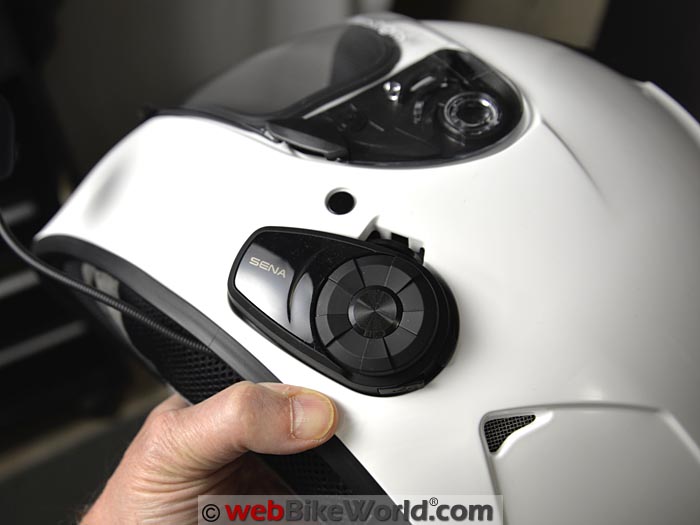

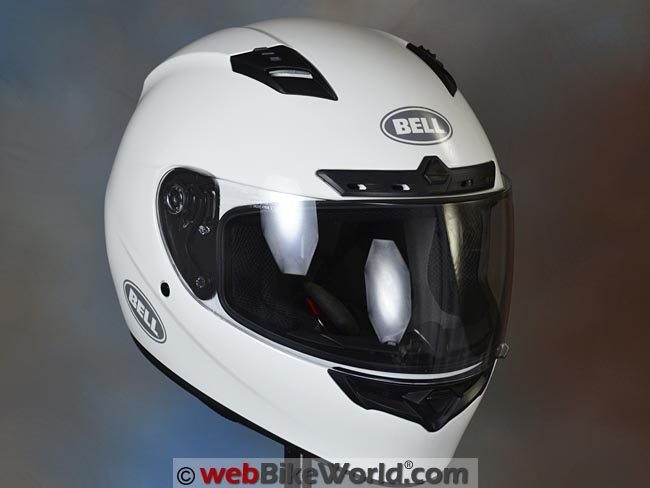
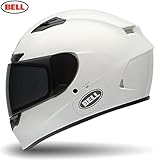


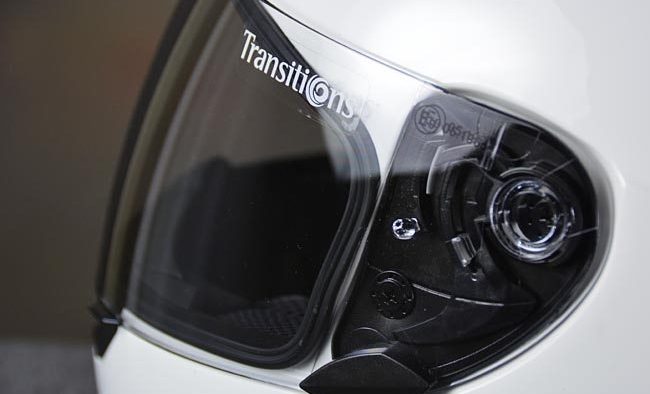
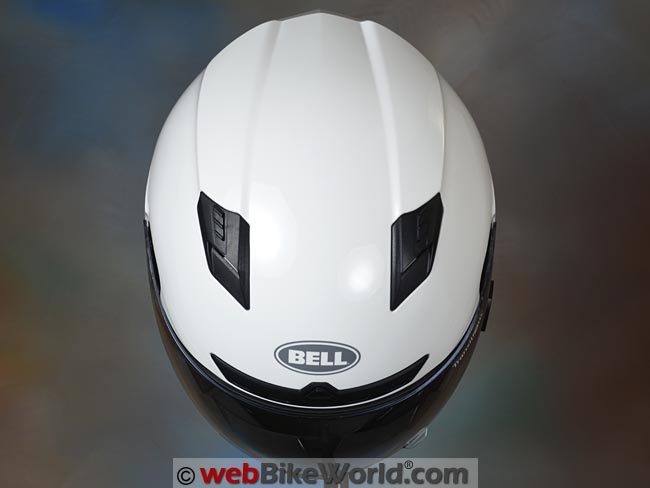
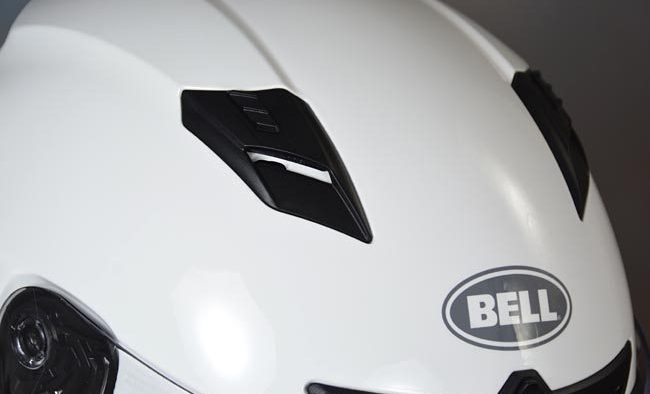
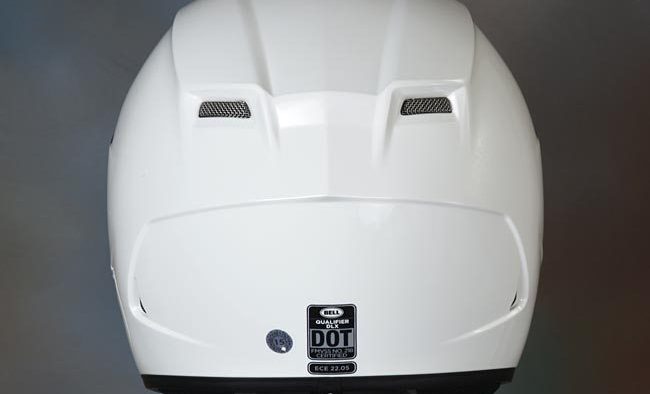
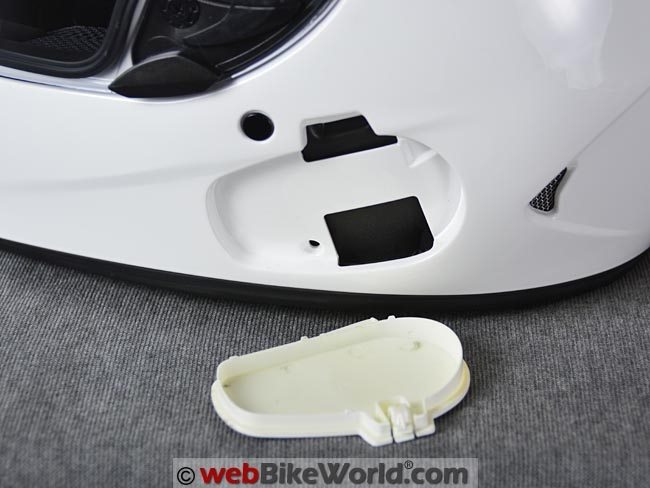
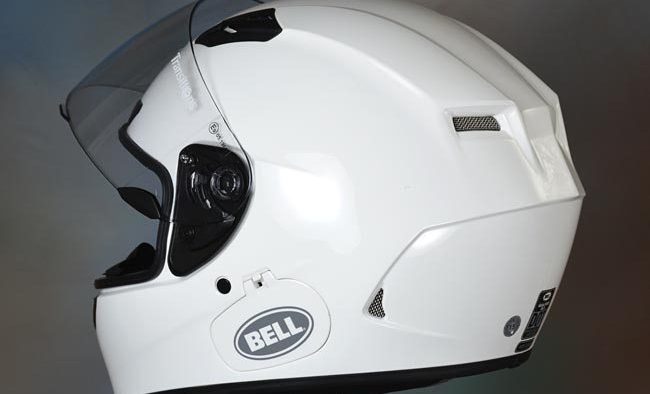
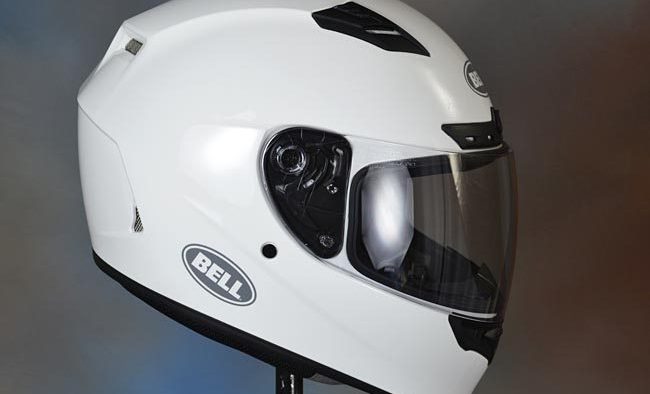
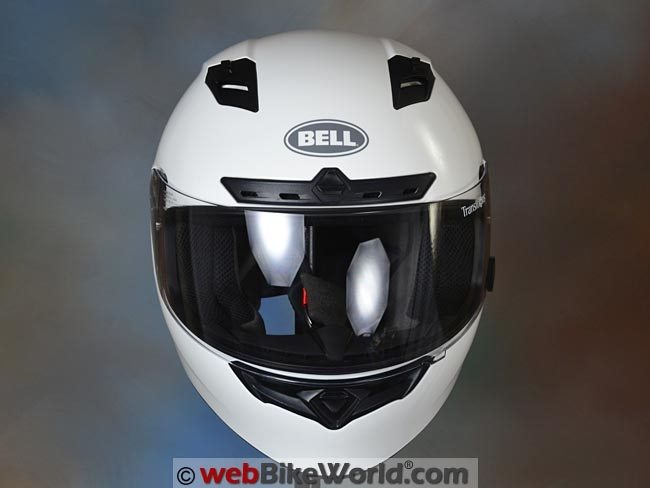
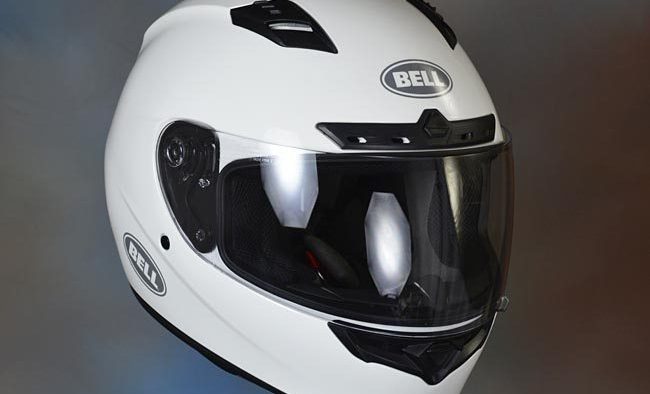

No Comment